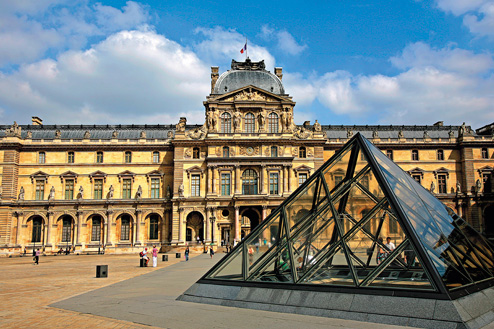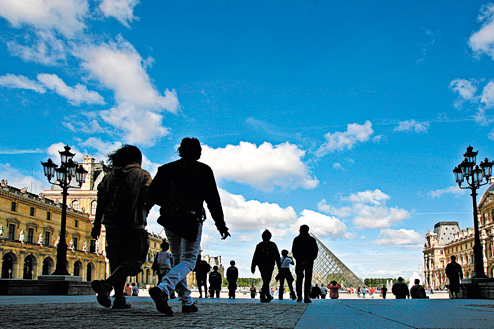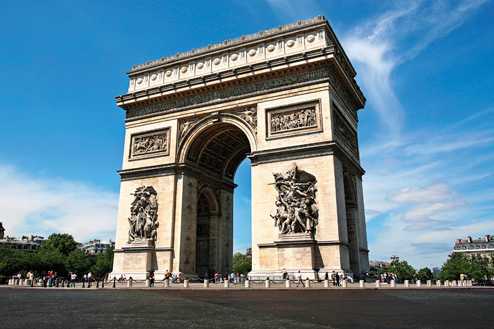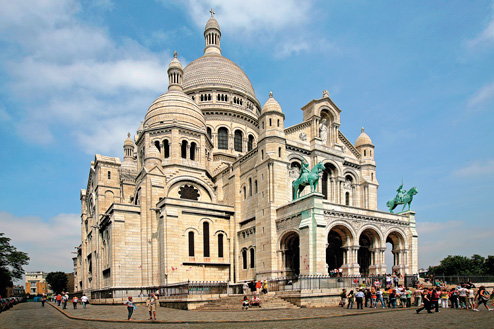Île de la Cité
While some other parts of Paris tend to quieten down during the month of August, the Île de la Cité becomes busier than ever. This is the cradle of Paris, the island settled by the Celtic Parisii and the town the Romans knew as Lutetia. Hausmann’s 19th century clean-up operation was radical, but at least it had the effect of focussing the spotlight on two major landmarks: La Conciergerie and Notre-Dame. The island’s other must-see attraction is La Sainte-Chapelle, whose delicate spire soars above its immediate surroundings.
To get a good sense of the island, an attractive approach is the Pont-Neuf. In 1607, it was a novelty, the first bridge to be furnished with pavements where pedestrians could escape a splattering from muddy carriage wheels. It’s now the city’s oldest bridge. At its mid-point is a statue of a genial-looking Henri IV on horseback. Down some steps is the square du Vert Galant (the name is an allusion to the king’s evergreen philandering). It’s a pretty garden, shaped like a ship’s prow, and you can jump on one of the Vedettes du Pont-Neuf here if the fancy takes you. Back at street level, place Dauphine is a surprisingly peaceful refuge of cobblestones, chestnuts, gently bulging facades and a handful of restaurants. At the square’s far end, where the royal Palais de Saint-Louis once stood, is the Palais de Justice. Flanking the quai de l’Horlogerie, the turreted Conciergerie is an imposing survivor from the Middle Ages. Outside you’ll see the city’s first public clock (the original 14th century timepiece has been replaced by a 1585 model). The entrance of La Sainte-Chapelle is signposted, though you’ll probably spot the queue first.
On place Lépine, there’s a thriving flower market, its stalls swelled by birds and pets on Sundays. The Préfecture de Police along quai des Orfèvfres is the stuff of legend for Maigret readers, as well as viewers of many a contemporary TV cop show. The rest of the island is dominated by the Cathédrale de Notre-Dame. In high season, there’s little chance of escaping the throngs here (though with a guided tour you’ll at least shuffle intelligently). The ascent to the towers often involves a similar wait, but it’s soon forgotten when you’re gazing out among the gargoyles (not many 19th century embellishments can claim to have added such ‘value’ to an ancient monument).
Not just the spiritual centre of Paris, Notre-Dame is the road-map hub of France. Look for the bronze star near the west door marking ‘kilomètre zéro’, the location from which all distances are measured. Also on the square is the Crypte Archéologique where, with a little imagination, you can discover how the Cité settlement grew. Away from the tat-lined thoroughfares, there are glimpses of the past; along rue Chanoinesse, for example, where, in around 1200, Abélard fell for Héloïse (an affair brutally terminated in his castration). At the ‘stern’ of the island is the claustrophobic Mémorial de la Déportation, honouring the 200,000 French who died in Nazi concentration camps. Inside, its sculpture and inscriptions are fittingly stark.
To get a good sense of the island, an attractive approach is the Pont-Neuf. In 1607, it was a novelty, the first bridge to be furnished with pavements where pedestrians could escape a splattering from muddy carriage wheels. It’s now the city’s oldest bridge. At its mid-point is a statue of a genial-looking Henri IV on horseback. Down some steps is the square du Vert Galant (the name is an allusion to the king’s evergreen philandering). It’s a pretty garden, shaped like a ship’s prow, and you can jump on one of the Vedettes du Pont-Neuf here if the fancy takes you. Back at street level, place Dauphine is a surprisingly peaceful refuge of cobblestones, chestnuts, gently bulging facades and a handful of restaurants. At the square’s far end, where the royal Palais de Saint-Louis once stood, is the Palais de Justice. Flanking the quai de l’Horlogerie, the turreted Conciergerie is an imposing survivor from the Middle Ages. Outside you’ll see the city’s first public clock (the original 14th century timepiece has been replaced by a 1585 model). The entrance of La Sainte-Chapelle is signposted, though you’ll probably spot the queue first.
On place Lépine, there’s a thriving flower market, its stalls swelled by birds and pets on Sundays. The Préfecture de Police along quai des Orfèvfres is the stuff of legend for Maigret readers, as well as viewers of many a contemporary TV cop show. The rest of the island is dominated by the Cathédrale de Notre-Dame. In high season, there’s little chance of escaping the throngs here (though with a guided tour you’ll at least shuffle intelligently). The ascent to the towers often involves a similar wait, but it’s soon forgotten when you’re gazing out among the gargoyles (not many 19th century embellishments can claim to have added such ‘value’ to an ancient monument).
Not just the spiritual centre of Paris, Notre-Dame is the road-map hub of France. Look for the bronze star near the west door marking ‘kilomètre zéro’, the location from which all distances are measured. Also on the square is the Crypte Archéologique where, with a little imagination, you can discover how the Cité settlement grew. Away from the tat-lined thoroughfares, there are glimpses of the past; along rue Chanoinesse, for example, where, in around 1200, Abélard fell for Héloïse (an affair brutally terminated in his castration). At the ‘stern’ of the island is the claustrophobic Mémorial de la Déportation, honouring the 200,000 French who died in Nazi concentration camps. Inside, its sculpture and inscriptions are fittingly stark.













